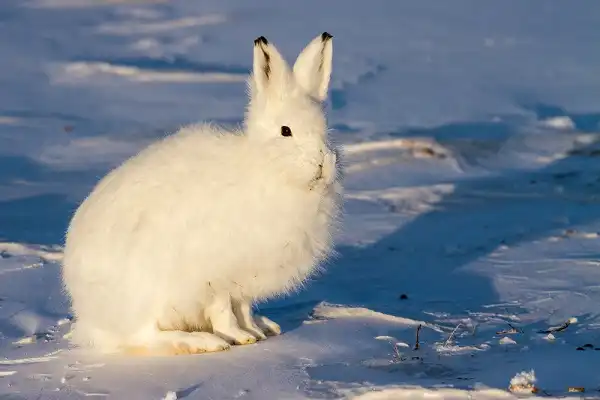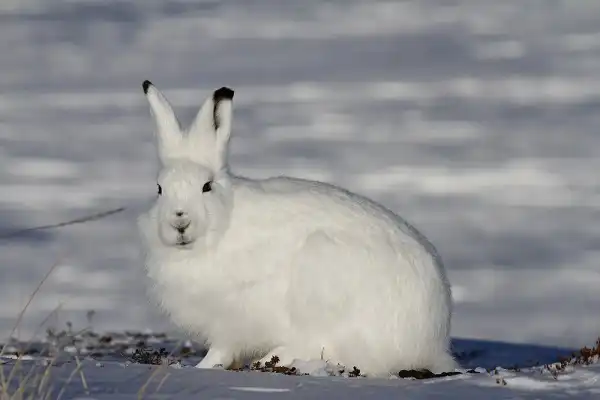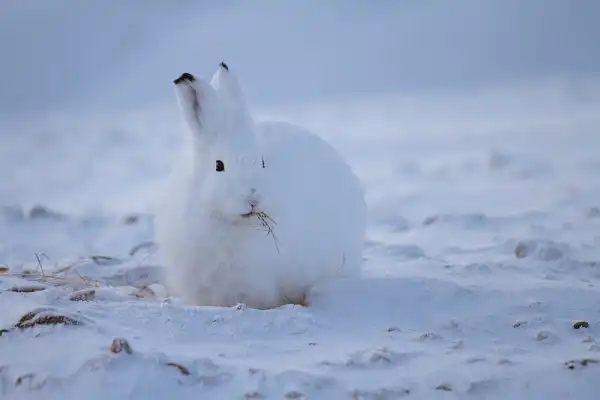As the cold weather rolls in, no one is better prepared for the low temperatures than the Arctic hare. This hardy species of rabbit can survive through winters thanks to its thick fur, wide feet, and kilograms of stored body fat – all helping it blend into its icy habitat and keep warm even during extreme cold snaps. With more adaptations than just keen winter survival skills, this curious creature is a fascinating example of nature at work. Here we’ll explore why Arctic hares are so well adapted for life on snow-packed tundra grasslands, what threats they face despite their superior adaptation training, and how you can help defend them against an uncertain future.

Arctic Hare Description
The Arctic hare is a fascinating species of rabbit that has evolved to perfectly suit life in its frigid environment. Its dense fur provides both insulation and camouflage against the snowy backdrop. Additionally, its broad feet enable the hare to distribute its weight over a wide surface area, preventing it from sinking into the snowdrifts. The Arctic hare’s dense fur coat, which is composed of both long guard hairs and short underfur, serves as both insulations against the cold and camouflage against predators such as Arctic foxes and birds of prey. The fur is typically white in the winter months, providing excellent camouflage against the snow, and may turn brown or gray in the summer months to better blend in with the vegetation. However, it’s not just the Arctic hare’s physical attributes that make it such a remarkable animal.
Arctic Hare Habitat
The Arctic hare’s preferred habitat is the snow-packed tundra grasslands found throughout the Arctic regions of North America, Greenland, and Europe. These vast, treeless plains are characterized by their bitter temperatures and relatively low biodiversity. Despite these harsh conditions, the Arctic hare has evolved to make the most of its surroundings. Throughout the long summer months, the Arctic hare feeds on a variety of grasses, sedges, and flowering plants. This diet provides the hare with the nutrients and energy it needs to build up its body fat – a crucial component in its survival strategy. As the days grow shorter and the temperature begins to drop, the Arctic hare switches its diet to tougher, less-nutritious plant material such as twigs and bark.
Using specialized enzymes and stomach acids, the hare is able to extract the maximum amount of nutrition from these otherwise inedible sources. Unfortunately, this unique habitat is under threat. Industrial activities such as oil and gas exploration, mining, and transportation infrastructure development are encroaching on the Arctic tundra at an alarming rate. Climate change is also affecting the Arctic region, causing unpredictable weather patterns and melting permafrost – a crucial component of the tundra ecosystem. Without concerted conservation efforts, the Arctic hare and numerous other species could soon be pushed to the brink of extinction.
Arctic Hare Diet
The Arctic hare has an impressive and unique diet that has allowed it to thrive in the harsh and unforgiving tundra environment. During the summer months, the hare feeds on a variety of nutrient-rich grasses, sedges, and flowering plants. These plants provide the hare with the energy and nutrients it needs to build up its body fat reserves, which are essential for surviving the long, cold winter months. As the temperatures begin to drop and the days grow shorter, the Arctic hare switches to a diet of tougher, less-nutritious plant material such as twigs and bark. To extract the maximum amount of nutrition from these otherwise inedible sources, the hare has evolved specialized digestive processes, including the production of specialized enzymes and stomach acids.

Arctic Hare Size
The Arctic hare may not be the largest animal in its habitat, but its size is still an important factor in its survival. Adult Arctic hares can grow up to 60 centimeters in length and weigh between 2 and 5 kilograms, with males being slightly larger than females. Their compact size allows them to conserve body heat in the harsh Arctic climate, while their large hind legs and broad, furry feet enable them to move quickly and easily over the snowy terrain. Despite these physical adaptations, the Arctic hare faces many challenges in its environment. The Arctic is one of the fastest-warming regions on Earth, with average temperatures rising three times faster than the global average. As a result, the Arctic permafrost is melting, altering the delicate balance of the tundra ecosystem and threatening the survival of many of its inhabitants, including the Arctic hare.
Arctic Hare Lifespan
The Arctic hare has a relatively short lifespan compared to other mammals. In the wild, they typically live for around 3 to 5 years, although some individuals have been known to survive for up to 7 years. One of the main factors that affect the Arctic hare’s lifespan is its ability to survive the harsh conditions of its environment. During the winter months, temperatures can drop as low as -40 degrees Celsius, and food can be scarce. The hare’s ability to store body fat reserves is crucial for its survival, as it allows the animal to conserve energy and stay warm during long periods of hibernation. Another factor that plays a role in the Arctic hare’s lifespan is its susceptibility to predation. Despite its impressive speed and agility, the Arctic hare is still preyed upon by a number of predators, including Arctic foxes, wolves, and birds of prey. The hare’s camouflage and ability to blend in with its surroundings are crucial for avoiding detection by these predators. Human activities also pose a threat to the Arctic hare’s survival, with habitat loss and climate change being two of the biggest drivers of population decline. As the Arctic continues to warm at an unprecedented rate, the delicate balance of the tundra ecosystem is being disrupted, putting the survival of many of its inhabitants, including the Arctic hare, at risk.
Arctic Hare Behavior
Arctic hare behavior is a fascinating topic, as this species has developed unique adaptations to survive in its harsh environment. One of the most remarkable aspects of Arctic hare behavior is their ability to change their fur coloration according to the seasons, which provides excellent camouflage against potential predators. During the winter months, the Arctic hare’s fur turns white, whereas, in the summer months, it changes to brown or gray to blend in with the vegetation. Another interesting behavior of the Arctic hare is their hibernation pattern. During the winter months, when food is scarce and the temperatures are very low, the Arctic hare enters a state of hibernation to conserve energy. This means that they can survive for long periods without food, relying on their body fat reserves to keep them warm and provide the necessary energy to survive until spring.

Arctic Hare Speed
The Arctic hare’s speed is one of its most impressive adaptations for survival. These hares have a remarkable running ability, with strong hind legs that allow them to reach speeds of up to 60 kilometers per hour. This fast-paced movement enables them to escape from predators, including arctic foxes, wolves, and birds of prey. In addition to their impressive sprinting ability, the Arctic hare’s speed is also related to their overall agility. They are incredibly nimble animals, able to change direction quickly and abruptly to avoid obstacles or evade predators. This agility is aided by their small body size, which also makes them less noticeable to potential predators in their environment. Furthermore, the Arctic hare’s speed is coupled with their incredible endurance. These hares are known to run for long periods, covering impressive distances without stopping. This is an important adaptation for their survival, as it allows them to outrun predators and search for food in a vast and challenging landscape.
Arctic Hare Hunting
Arctic hare hunting is a challenging and dangerous activity for predators in the harsh Arctic environment. These small and agile animals have adapted unique behaviors that make them formidable prey for predators such as wolves, arctic foxes, and birds of prey. Arctic hares are known to be extremely alert and vigilant, constantly scanning their environment for potential threats. They have excellent eyesight and can detect movement from great distances, enabling them to spot predators early and take evasive action. In addition to their visual acuity and camouflage, Arctic hares have developed impressive speed and agility. These hares have strong hind legs that allow them to reach speeds of up to 60 kilometers per hour, making it challenging for predators to catch them. They can also change direction quickly and abruptly, evading predators by leaping and dodging through the difficult terrain of the Arctic landscape.
Arctic Hare Reproduction and Life Cycle
In addition to their hunting strategies, Arctic hares also have evolved a variety of reproductive behaviors that help them survive in the harsh Arctic environment. These animals can reproduce quickly and in large numbers, making them resilient to environmental changes and predation pressures. Arctic hares typically reproduce seasonally and are capable of producing up to 4 litters per year with an average litter size of 2 or 3 young. The timing of reproduction is closely linked to food availability; females usually give birth when food is plentiful so that their young will have enough nourishment for growth and development. Like many other mammals, female Arctic hares provide maternal care for their young until they become independent around 8–10 weeks old. Young hares cannot survive in the cold climate of their Arctic home, so their mother provides warmth and protection until they are old enough to fend for themselves.

Conclusion
The Arctic hare is a remarkable species capable of thriving in the harsh conditions of the Arctic landscape. Despite their small size, these animals have developed impressive adaptations that enable them to evade predators and search for food. By understanding their unique behaviors and adaptations, we can continue to develop conservation efforts that support their survival and protect this species for generations to come. With proper management, we can ensure that the Arctic hare remains an integral part of the Arctic ecosystem for many years to come.
Frequently Asked Question

